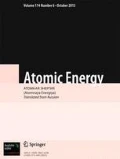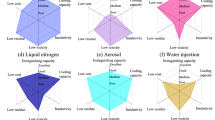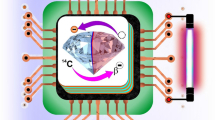It is shown that the technological scheme for fabricating uranium dioxide pellets is suitable for fabricating uranium-molybdenum pellets. It permits using the standard powder metallurgy methods to fabricate pellets from uranium-molybdenum powder obtained by thermocentrifugal atomization of ingots of uranium-molybdenum alloy. The proposed technology uses standard equipment operating in easily reproducible regimes.
Similar content being viewed by others
References
R. O. Montgomery, W. D. Bennett, C. H. Henager, et al., “An innovative accident tolerant LWR fuel rod design based on uranium-molybdenum metal alloy,” in: Top Fuel 2016, USA, Boise (2016), pp. 1375–1385.
V. V. Kalashnikov, V. V. Titova, G.Ya. Sergeev, and A. G. Samoilov, “Uranium-molybdenum alloys in reactor engineering,” At. Energ., 5, No. 4, 421–431 (1958).
I. V. Dobrikova, A. V. Vatulin, Yu. V. Konovalov, et al., “Development of uranium-molybdenum low-enriched high-density fuel for Russian research reactors,” Vopr. At. Nauki Tekn. Materialoved. Nov. Mater., No. 2(73), 20–29 (2012).
A. V. Vatulin, I. V. Dobrikova, V. B. Suprun, and V. G. Kulakov, “Development of high-density fuel for research reactors,” Vopr. At. Nauki Tekn. Materialoved. Nov. Mater., No. 1(74), 39–49 (2013).
V. Sinha, G. Prasad, P. Hegde, et al., “Development, preparation and characterization of uranium molybdenum alloys for dispersion fuel application,” J. Alloys Compounds, 473, 238–244 (2009).
F. G. Reshetnikov (ed.), Development, Production and Operation of Fuel Rods for Power Reactors, Energoatomizdat, Moscow (1995), Vol. 1.
A. N. Zhiganov, V. V. Guzeev, and G. G. Andreev, Uranium Dioxide Technology for Ceramic Nuclear Fuel, STT, Tomsk (2002).
Y. E. Geguzin, Physics of Sintering, Nauka, Moscow (1967).
S. S. Kiparisov and G. A. Libenson, Powder Metallurgy, Metallurgiya, Moscow (1980).
O. A. Bakhteev, A. V. Lysikov, N. A. Degtyarev, et al., “Infl uence of the porosity parameters of fuel pellets on the pellet caking capacity,” Vopr. At. Nauki Tekn. Materialoved. Nov. Mater., No. 4 (95), 109–115 (2018).
O. A. Bakhteev, A. V. Lysikov, E. N. Mikheev, Certif. State Registr. Comp. Progr., No. 2013660806, “IRBIS software for image analysis of submicron porosity” (2013).
Author information
Authors and Affiliations
Corresponding author
Additional information
Translated from Atomnaya Énergiya, Vol. 127, No. 5, pp. 293–295, November, 2019.
Rights and permissions
About this article
Cite this article
Lysikov, A.V., Mikheev, E.N., Karpyuk, L.A. et al. Evaluation of the Possibility of Fabricating Uranium-Molybdenum Fuel for VVER by Powder Metallurgy Methods. At Energy 127, 324–327 (2020). https://doi.org/10.1007/s10512-020-00630-6
Received:
Published:
Issue Date:
DOI: https://doi.org/10.1007/s10512-020-00630-6




